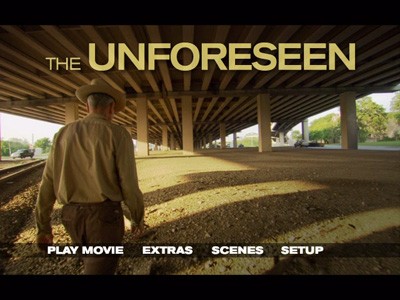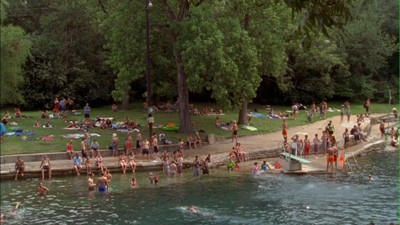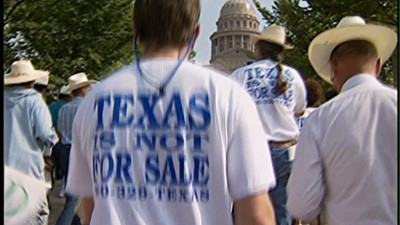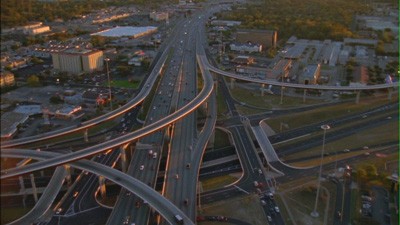| Reviews & Columns |
|
Reviews DVD TV on DVD Blu-ray 4K UHD International DVDs In Theaters Reviews by Studio Video Games Features Collector Series DVDs Easter Egg Database Interviews DVD Talk Radio Feature Articles Columns Anime Talk DVD Savant Horror DVDs The M.O.D. Squad Art House HD Talk Silent DVD
|
DVD Talk Forum |
|
|
| Resources |
|
DVD Price Search Customer Service #'s RCE Info Links |
|
Columns
|
|
|
Unforeseen, The
THE MOVIE:

What with all the talk of the subprime mortgage crisis and how it's effecting the common citizenry, many of whom are losing their homes, it's hard to imagine that most people looking to watch a good documentary would want to pick a film about the long-lasting effects of urban sprawl; yet, the recent arrival of Laura Dunn's The Unforeseen on DVD would almost seem like fortuitous planning as, in a lot of ways, its message is exactly what we need to hear. Though land development is the topic of choice, the greater meaning of The Unforeseen extends beyond who wants to build houses where; rather, it encourages us to stop and think about what it is we may be doing, to take stock of how our actions today may impact our future. One hopes in all this talk of bailouts and quick fixes, cool heads might prevail and think about what will happen when the band-aids will need to be replaced.
Dunn's movie takes its basic narrative structure from the ups and downs of Gary Bradley, a land developer who left a small town in West Texas to seek his fortune in Austin in 1972. Bradley conceived of the Circle C Ranch, an expansive suburb that would create 10,000 affordable homes. Bradley's efforts were beset with problems from the start, but he hit a real wall in the 1980s when the savings & loan failure suddenly left him in debt without any security. In this climate, a bigger corporation, Freeport/McMoRan, stepped in and appended their Barton Creek development to Circle C. When the local community caught wind of what was going to happen, they feared for their natural resources, specifically the natural waters of Barton Springs, where Austin families had been swimming for generations. An unprecedented level of community protest arose, and the city government had no choice but to go with the will of the people, severely limiting what Bradley and his new allies could do on their land.
From there sprung a long, protracted battle of private property rights versus public property rights. On one side, you had land owners and business entrepreneurs who didn't want the government regulating what they could do with their property, and on the other were environmentalists and community activists who were concerned about the desires of the individual eclipsing the things that were intended to be shared by everyone. It's the unforeseen effects that worried those on the side of regulation. For instance, the local rancher who one day discovered his well was dry because the added population beyond his property line was not only effecting how the rainfall traveled and keeping his well from being replenished, but they were also changing how the water flowed through the ground, and he was likely now sharing with everyone. It's what Daniel Plainview would call "drainage."

The case for The Unforeseen is made by environmental lawyers, politicians, and other people who were there, including former Texas Governor Ann Richards, Rolling Stone reporter William Greider, and actor Robert Redford, who is one of the film's producers and who grew up swimming in Barton Springs. Examples of how the clarity of the water has changed are shown, and a couple of local farmers share tales of how the mushrooming suburbs are squeezing them out. Though Dunn's point of view skews heavily against sprawl, she is careful not to vilify anyone, giving some screen time to the pro-private property rights protests in the 1990s and also talking to average families who are benefiting from being able to afford bigger homes for less by moving to Texas' Hutto suburb. Even Gary Bradley gets his due, portrayed somewhat as a small-town boy chewed up by his own ambition. The only clear dastardly character in this story is Dick Brown, the faceless lobbyist who helped push a bill through the Senate that would allow developers to grandfather in old regulations for new work, a bill that was only successful once George W. Bush replaced Richards in office. This lobbyist works on building a model air bomber while he talks, including plastic replicas of its deadly cargo, a visual conceit that some could be seen as Dunn being too heavy handed if this fellow didn't hang himself with his own words. He says straight out that his intent was "redress and revenge."
Dunn displays a visual acumen throughout the film that saves The Unforeseen from its somber tone and makes the documentary a soulful rumination on what it means for human beings to live on this planet. She uses some slick graphics to make her points, particularly showing how a housing tract in one area can reach across the landscape to pull in the resources it needs (Hutto, for instance, does not have its own central water source). Dunn's greatest asset in explaining her intentions, however, is the beautiful way in which her cameramen, Lee Daniel (Richard Linklater's cinematographer) and Vance Holmes, shoot Barton Springs and the rest of the land, including the desolate, failing farms and strangling highway system that runs down the center of Austin. In addition to Redford, The Unforeseen's other famous producer is director Terrence Malick (Badlands, The New World), an Austin native who originally conceived of the film's central concept. The lovely photography and even some of the languorous voiceover from farmer poet Wendell Berry would be right at home in one of Malick's own dramas. If there is any complaint to be had about this movie, it's sometimes too languorous, but that would be a very small gripe.
The Unforeseen doesn't pretend to have all the answers nor does it attempt to deny that human beings have a need for a place to live. On the contrary, its main goal is to make people consider how to improve the places that have already been developed and make those communities better rather than engage in unnecessary expansion. As William Greider explains, the problem with a lot of expansion is that it follows the economic theory that any moneymaking endeavor is a mark in the plus column and no one ever stops to think of the quality of the achievement. What I took away from this film is that it's not a question of good vs. evil or even sharing vs. greed, but instead it's about doing away with the thinking that what is right for right now will always be so. You can't just act and worry about the consequences later, and there is no reason that making life better today can't be done while also ensuring a better tomorrow.

THE DVD
Video:
The Unforeseen has been mastered for DVD with a 1.85:1 anamorphic widescreen transfer that is excellent. The image quality is crisp with sumptuous colors, and the only glitches I saw were the result of older source material.
Sound:
The soundtrack is also given the full treatment, with a 5.1 audio mix and a 2.0 stereo mix, both of which sound stupendous. The documentary has beautiful pre-existing music by people like Patti Griffin, Jeff Beck, Icelandic avant-garde ensemble Sigur Ros, and composer Arvo Part, and The Unforeseen is as gorgeous to listen to as it is to look at.
There are no subtitle options.
Extras:
The DVD comes with the theatrical trailer for the movie, as well as a full-color paper insert featuring a new essay by film critic Dennis Lim.
It also has a full-length audio commentary by director Laura Dunn, producer and motion graphics designer Jef Sewell, sound designer Tom Hammond, and cinematographer Lee Daniel. The four are in the room together, dissecting the construction of the movie, explaining where the archive footage came from and also how they created and/or achieved their new shots. It can be a little hard to remember who is who among the men, but it doesn't stop the track from being interesting. Dunn also talks about why she made certain choices, including how she picked her subjects and how the narrative of the movie came together. The commentary was recorded more recently than the film was made, so that means that Dunn and Sewell can also relate to current financial woes of the U.S. back to the S&L scandals in the 1980s.
FINAL THOUGHTS:
Recommended. Laura Dunn's The Unforeseen is an elegantly constructed examination of how urban development has an impact beyond the immediate area and beyond the immediate present. It also chronicles the struggles in Texas, centered on the Barton Springs area near Austin, to settle questions regarding the clash between private property rights and the public good. Though working under a specific thesis, Dunn is a fair filmmaker who manages to make a persuasive argument without giving short shrift to her opponents. It's a timely film that will make you think about the changes afoot in our country and the crises we all face. The Unforeseen is hopeful and thought provoking at the same time.

Jamie S. Rich is a novelist and comic book writer. He is best known for his collaborations with Joelle Jones, including the hardboiled crime comic book You Have Killed Me, the challenging romance 12 Reasons Why I Love Her, and the 2007 prose novel Have You Seen the Horizon Lately?, for which Jones did the cover. All three were published by Oni Press. His most recent projects include the futuristic romance A Boy and a Girl with Natalie Nourigat; Archer Coe and the Thousand Natural Shocks, a loopy crime tale drawn by Dan Christensen; and the horror miniseries Madame Frankenstein, a collaboration with Megan Levens. Follow Rich's blog at Confessions123.com.
|
| Popular Reviews |
| Sponsored Links |
|
|
| Sponsored Links |
|
|
| Release List | Reviews | Shop | Newsletter | Forum | DVD Giveaways | Blu-Ray | Advertise |
|
Copyright 2024 DVDTalk.com All Rights Reserved. Legal Info, Privacy Policy, Terms of Use,
Manage Preferences,
Your Privacy Choices | |||||||













